Please Note: This article
reproduces historic barrel browning recipes that contain
toxic ingredients. They are not to be
attempted and
are provided here for academic purposes only.
From Bright Steel to Brown:
The Colour of British Musket Barrels, 1755-1865
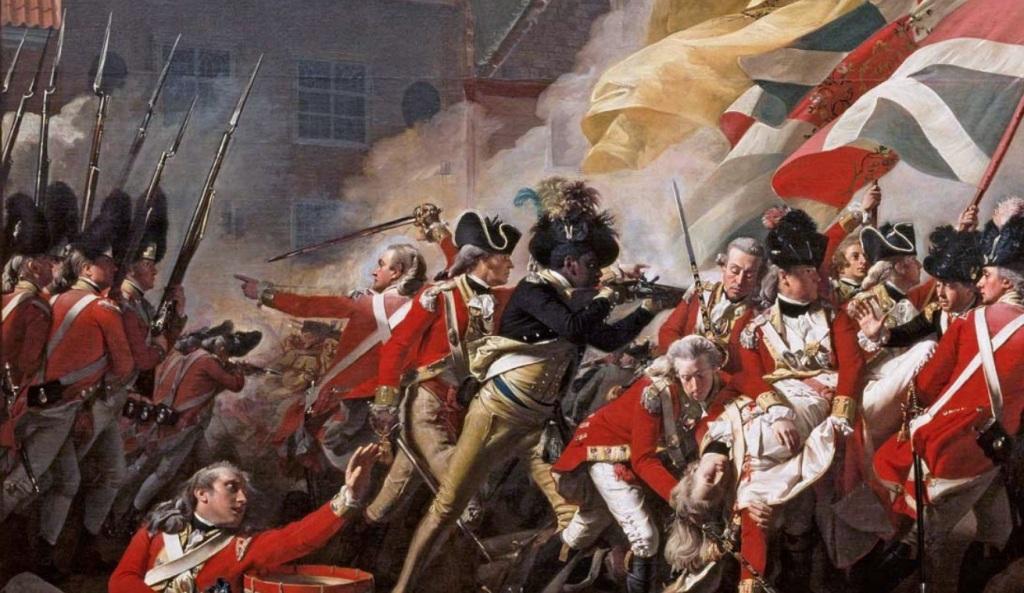
Detail showing a
British Grenadier Company with polished Short Land Brown Bess muskets.
Reproduction of that musket found here.
From The Death of Major Peirson, 1781 by John Singleton Copley
(painted in 1783)
While sportsmen had started browning their musket
barrels for hunting since the middle of the 18th century, muskets issued to
British regulars prior to the American Revolution
were expected to be brightly polished. Cuthbertson in 1768, writing on
the British Army considered the polished musket as a sign of pride
and profession.
Orders for the Nottinghamshire Marksman in 1778
highlighted its importance:
"..Such
being the importance of his Arms, no wonder that a soldier should shew his
attachment to his Firelock, by keeping it as bright as the Sun, and looking
upon it with a kind of veneration. A glittering Firelock is a prime ornament
of a Soldier and gives to every movement an appearance of double Life and
Spirit."
In some
instances bright arms had unexpected results.
During the American
Revolution just before the Battle of Guildford Courthouse, the American
General Lee was thrown from his startled
mount caused by the sun reflecting off the bright arms of
the opposing British troops.1 The polishing of the brown bess musket by British troops bordered on
obsessive compulsive. In 1776 Lord Townshend saw the raising cost of
polishing arms as extravagant: "The great expenditure of arms is [due]
to the unnecessary high polish, and injudicious manner in which some
Regiments treat them." The damage to the
barrels was significant. For example, in 1775 the arms of the 62nd
Regiment of Foot were reported to "have been so abus'd to keep them
bright, that there is not the appearance of the Kings mark." At the opening of the American Revolution,
the idea of browning barrels was considered by the British Ordnance, but
was rejected. 2
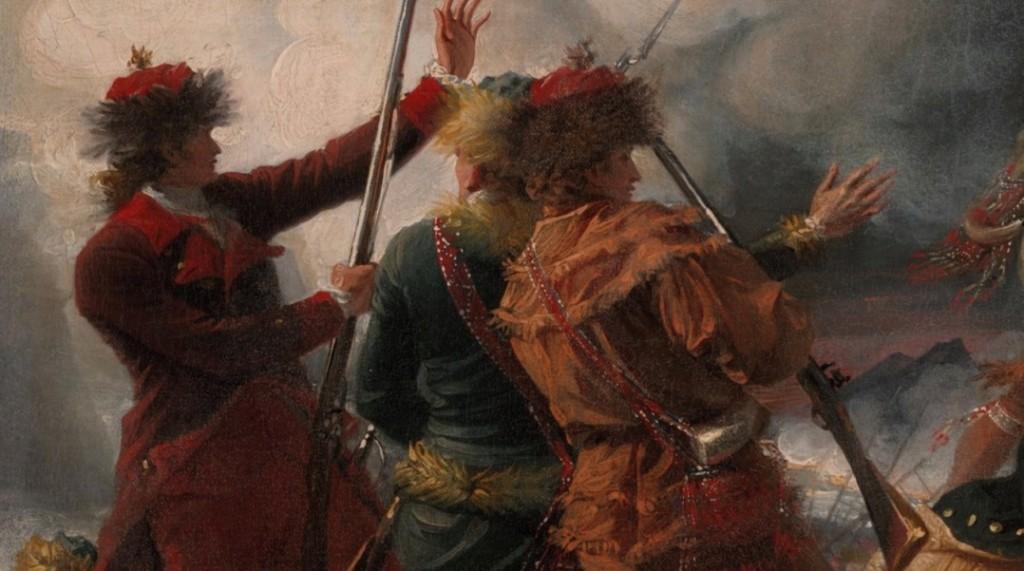
In his 1786 painting of the Death of General Montgomery
in the Attack on Quebec (1775), John Trumbull
suggests American soldiers also polished their muskets. Appears to be the
Long Land Brown Bess Musket.
Replica of that brown bess found here.
The preference for bright barrels
continued amongst line regiments throughout the Napoleonic Wars.
James wrote in his
Military Dictionary in 1805:
"the private soldier familiarly calls his firelock
brown bess; although the term is little applicable to the weapon, considering that it is
absurdly polished in almost every Regiment in the British Army."
One soldier,
Shadrack Byfield of the 41st Regiment, used this to identify friend from foe in the night
after the capture of Fort Niagara in 1813: "A short time after, we saw another man,
with polished arms, by which I knew he must be one of our men...He belonged to the
Royals."
The most common substances used in the 18th
century to clean the barrel was brick dust or emery powder mixed with sweet
oil (olive oil). One technique was to glue emery to a flat leather
covered deal wood stick and the scrub the barrels clean while applying oil
and emery or brick dust during the process.
After cleaning, the soldier then buffed the barrel to a high
polished state by burnishing it with his ramrod or rubbing it with a
wooden buffing stick. By the 1780s, crocus martis powder (jeweller's
rouge), was applied with a piece of clean leather, was used in the polishing
step producing a mirror finish. Soldiers would purchase crocus
privately and were compensated with an allotment of "crocus money" from the
army.
The obsession with maintaining a mirror finish
on the barrel did have a negative impact on its state.
For example,
in 1775, the 62nd Regiment's arms were reported as being "so Abus'd
to keep them bright, that there is not the least appearance of the Kings
mark".3
Other regiments
during the Napoleonic wars reported weak and worn barrels.
Efforts were made by army officials to deter this wear - caused mostly by
the practice of burnishing.
In 1795 the 43rd Regiment ordered:
"The men
must keep their arms... in the highest possible order with respect to
polish and cleanliness.... Every man must be supplied with a buff-stick
and other necessary articles for the purpose, and any man caught
polishing his barrel with his ramrod, or piece of iron, will be punished
for it."
However as
illustrated below these orders were mostly ignored.
In addition to wear, bright barrels had other disadvantages.
William Henry in his manual
A Media Plan for Military Animation at Fort George quoted an
interesting document on the subject.
In 1812, the colonel of the 102nd Regiment
ordered muskets of the regiment to be browned. An inspecting officer order the colonel to
submit a written explanation on why had done this.
His reasons for this were as
follows:
1. There was no regulation
against it.
2. The barrels could be made bright again with sand paper.
3. An order against burnishing the arms with the ramrods was seldom obeyed by other
Regiments.
Thus, if the 102nd (who presumably did not burnish their arms in
compliance with the order) were compared to other Regiments their arms would appear dirty,
thus hurting the pride of the 102nd.
4. Browning preserves the arms and they are cleaned with bees wax once or twice
every six months, thus, preventing rust and making it unnecessary to remove the barrel as
is so frequently done now.
5. The dazzle of bright arms prevents aim being taken in the sun - proof of this is
that brown barrels are universally used by sportsmen.
The colonel concluded his
explanation by stating that the men were pleased with the browning and that it helped to
get recruits from the Militia.
However the 102nd was far from the first to carry browned or "black" muskets in
the British service.
Over 50 years earlier in 1757 a less expensive brown bess was
introduced for Marine and Militia service that was not required to be polished.
The
finish for these muskets was referred to as "black" (likely
japanned).
British issue rifles from the first in 1776 seemed to have been
always browned.
The regulations for the Experimental Rifle Corps (later 95th
Regiment) in 1803 cautioned its men about not injuring the browning.
This echoed in
Barber's work in 1803: "The outside of the barrel should never be rubbed with
anything than can impair the brown."
But did regular regiments brown their
muskets prior to 1812?
The American Revolution had brought a number of innovations
and improvements to the British Army.
One area that saw a lot of activity was Light
Infantry.
Each regular regiment had a light company attached to it.
It appears
that these light companies were issued with black or browned muskets was early as
1787.
In an inspection return of the 38th Regiment of that year under the
category
"arms" it was noted : "the Light Infantry Company have the new black
barrels."
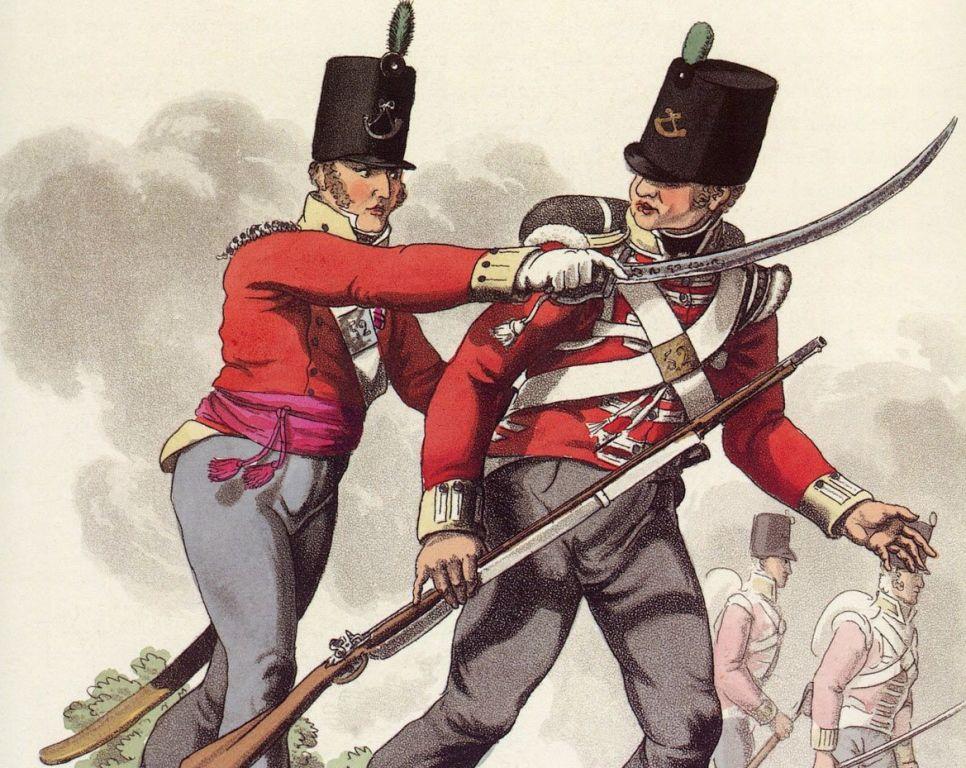
Sir John Moore's 52nd Regiment of Light Infantry carrying
the browned-barrelled
New Land pattern Brown Bess Musket.
Reproduction of musket can be
found here.
During the Napoleonic Wars a number of regiments were designated entirely light
infantry.
The first were the 43rd and 52nd Regiments followed by the 51st, 68th,
71st and 85th Regiments along with a number of Fencible corps.
All were influenced
by the innovations of the 52nd's colonel, Sir John Moore.
Moore altered the light
infantry drill was altered to be more efficient.
For example instead of making ready
at the recover position, Moore had his men come back to the prime position to make
ready.
This change allowed greater accuracy when presenting because the soldier no
longer had to struggle against the weight of a falling musket from the recover position
when presenting and aiming.
This innovation (and others) were adopted by the
other light infantry regiments and by 1812 the light company of at least one line
regiment, the 7th Regiment.
This practice was formally adopted for the entire army
in 1828.
Armed with the New Land Musket, the light infantry regiments shared in another
practice: browning barrels.
By the
end of the Napoleonic Wars, the tide had turned against bright steel.
On 22nd June
1815, four days after the Battle of Waterloo, orders were issued with instructions from
Horse Guards for all British Army muskets to be browned.
For those who are
interested in the browning process adopted by the British the following are
the instructions for browning issued in 1815 along with additional instructions a few
months later.
The browning process is controlled rusting by acids, which today we call
rust bluing. These orders are taken from General Regulations and Orders for the
Army, 1811 (revised 1816):
"Instructions for
Browning Gun Barrels
The following Ingredients:
Nitric Acid
1/2 ounce
Sweet Spirit of
1/2 ditto.
[toxic
ethyl nitrite]
Spirits of Wine
1 ditto.
[ethyl alcohol]
Blue Vitriol
2 ditto [copper sulfate]
Tincture of Steel
1 ditto.
[alcoholic solution of the
chloride of iron]
are to be mixed together,
the vitriol having been previously dissolved in a sufficient quantity of water to make
with the other ingredients, one quart of mixture.
Previous to commencing the
operation of Browning the Barrel, it is necessary that it be well cleaned from all
greasiness and other impurities, and that a plug of wood be put into its muzzle, and the
vent well stopped; the mixture is then to be applied with a clean sponge or rag, taking
care that every part of the Barrel be covered with the mixture, which must then be exposed
to the air for twenty-four hours, after which exposure the Barrel must be rubbed with a
hard brush and rag, to remove the oxid from the surface. This operation must be performed
a second and a third time (if necessary), by which the Barrel will be made of a perfectly
brown colour: it must then be carefully brushed and wiped, and immersed in boiling water,
in which a small quantity of alkaline matter has been put, in order that the action of the
Acid upon the Barrel may be destroyed, and the impregnation of the water by the Acid
neutralized.
The Barrel when taken from
the Water must, after being perfectly dry, be rubbed smooth with a burnisher of hard wood,
and then heated to about the temperature of boiling water; it then will be ready to
receive a varnish made of the following materials;
Spirits of Wine
1 Quart [ethyl alcohol]
Dragon's Blood powder 3 Drams
[bright red resin used in
varnish]
Shellac bruised
1 Ounce
and after the varnish is
perfectly dry upon the Barrel it must be rubbed with the burnisher to give it a smooth and
glossy appearance.
To repair and retain the
Brown upon Barrels.
When the Barrel is much
rubbed from use, a little vitriolic Acid may be applied to it, and then it must receive
the treatment that Barrels undergo in Browning, care being taken to deaden the action of
the Acid by means of boiling water.
When Brown Barrels are in
constant use tile Brown might be continually kept perfect by means of the application of
vinegar, which should remain upon the surface for a Day, and then be washed well with
boiling water.
If this operation be
repeated monthly, a Barrel which has been properly Browned in the first instance will
continue in a perfect state for many years.
Office of Ordnance,
16th July, 1815.
Additional Instructions for
Browning Arms.
The Barrel, with the Socket
and Neck of the Bayonet only, are to be Browned; they should he rubbed over either with a
fine File, or with coarse Emery Paper, previous to their receiving the Browning Liquid, in
order that its effect may be the greater.
In removing the Oxid from
the Surface of the Barrel, &c a Steel Scratch Brush will be found more
effectual than the hard Hair Brush; the use of the Steel Scratch Brush is
therefore to be
adopted. This part of the operation must be done with great care, as upon it depends the
proper Browning of the Barrel.
In moist Weather the operation of
Browning must be performed in as dry a situation as possible,
for humidity upon the Oxid weakens its effect, which must be
carefully guarded against.
The Locks are on no account
to be made of the Hardening Colour, as the repetition of the operation of hardening has a
very injurious tendency.
Office of Ordnance,
29th December, 1815"
It is important to emphasize that just the
barrel and the socket part of the bayonet were browned and blued. The
lock and ramrod remained bright steel. The approach of browning only
the barrel remained unchanged through the rest of the history of British
muzzleloading muskets and rifles, including the four models of the pattern
1853 Enfield. The browning process was first done at the factory but
then needed to be redone every two years by regiment's armourer.
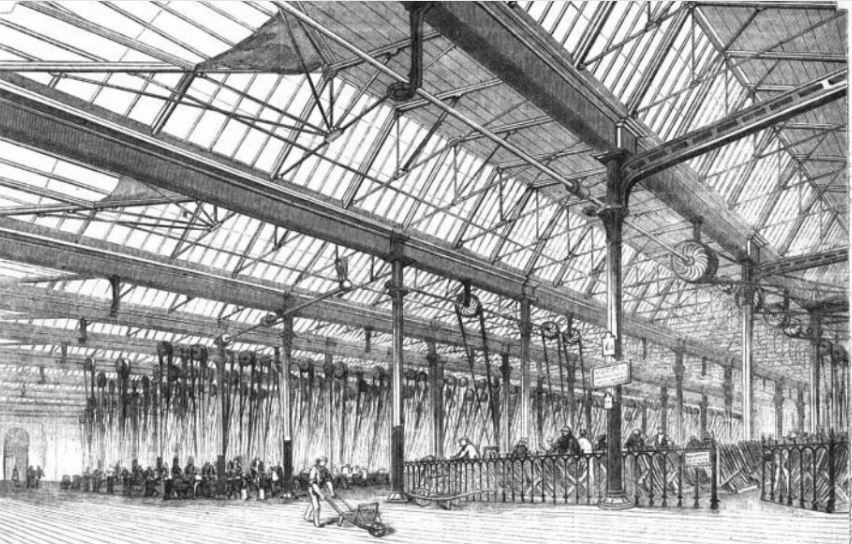
The Big Room at the Enfield Rifle Factory in 1861 There
was a separate Browning-room.
As a comparison with the original 1815 method,
the British Army modified the browning process in 1839. The recipe changed
in 1859 removing blue vitriol (copper sulphate). This may have been
mistake. In 1860 recipe changed again and a but the process
remained unaltered to the end of the production of the pattern 1853 Enfield
Rifle. Both the 1839 and the 1859 recipes are shown:
Instructions for Browning Gun Barrels
The following ingredients for the
browning of arms are to be mixed, and dissolved in one gallon of
soft water, viz:
|
[1839]
1 1/2 ounces of Spirits of wine
[ethyl alcohol]
1 1/2 ounces of Tincture of steel
[alcoholic of the chloride of
iron]
1/2 ounces of Corrosive sublimate
[toxic mercury chloride]
1 1/2 ounces of Sweet spirits of nitre
[toxic
ethyl nitrite]
1 ounce of blue vitriol
[toxic
copper sulfate]
3 ounces of Nitric acid
(are to be mixed and dissolved in one quart of soft water
[rain water] ) |
[1859]
6 ounces of Spirits of wine
6 ounces of Tincture of steel
2 ounces of Corrosive sublimate
6 ounces of Sweet spirits of nitre
3 ounces of Nitric acid
(the mixture is to be kept in glass, not in earthenware
bottles) |
Previous to commencing the operation of
browning, it is necessary that the barrel should be made quite
bright with emery or a fine smooth file (but not burnished), after
which it must be carefully cleaned from all greasiness; a small
quantity of pounded lime rubbed well over every part of the barrel
is best for this purpose: a plug of wood is then to be put into the
nose of the barrel and the mixture applied to every part with a
clean sponge or rag. The barrel is then to be exposed to the air for
twenty four hours: after which it is to be well rubbed over with a
Steel scratch-card or Scratch-brush, until the rust is
entirely removed; the mixture may then be applied again, as before
and in a few hours the barrel will be sufficiently corroded for the
operation of scratch brushing to be repeated. The same process of
scratching off the rust and applying the mixture is to be repeated
twice or three times a day for four or five days by which the barrel
will be made of a very dark brown colour.
The barrel is then to be exposed to the
air in a warm room for twelve hours, after which time it is to be
well rubbed over with a hard hair brush, or armourer's brush, until
the rust is entirely removed. The mixture is then to be applied
again in the same manner as before, and in six hours the barrel will
be sufficiently corroded for the operation of scratch-brushing. The
process of scratching off the rust and applying the mixture is to be
repeated twice or three times a day for four or five days by which
time the barrel will be of a dark brown colour. The rust which is
raised by each successive application of the mixture is always to be
removed at first with the hair brush previously to using the scratch
card as the latter is otherwise found to remove the browning. The
operation of scratch carding is only to commence after the second
application of the mixture.
When the barrel is sufficiently browned
and the rust has been carefully removed it is to be placed in
boiling water for three or four minutes in order that the action of
the acid mixture may be destroyed and the rust prevented from rising
again. The barrel while warm is to be rubbed over with sweet oil or
common olive oil. The operation for browning should be conducted in
a dry and warm room; a temperature of about 70 degrees is the most
favourable. The locks are on no account to be made of the hardening
colour as the repetition of the operation of hardening has a very
injurious tendency.
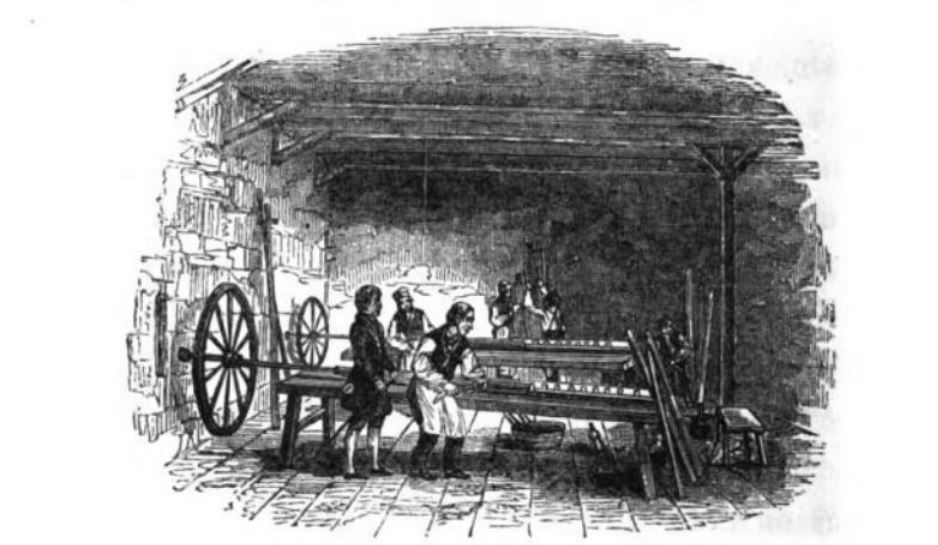
Boring and Grinding Gun Barrels, 1858
In December 1860 the process used by Infantry
regiments to re-brown their Enfield rifle muskets was further refined:
"WO. Circular. 653. 11 Dec. 1860
Browning recipe -
Tincture of steel 4 ounces
Sweet spirits of niture 4 ounces
Spirits of wine 3 ounces
Nitric acid 2 ounces (May 1862 order: concentrated
spec. grav. 1.42)
Blue Vitriol 1 ounces
Rain water 2 quarts
In mixing the ingredients the blue
vitriol should be dissolved in cold rain water, and the other
ingredients subsequently added.
The mixuture must be kept in a cool place, in glass bottles well
stoppered, as it will soon lose its virtue if kep in earthenware
jars, or if the stoppers do not fit well.
Directions for Browning
Before the mixture is applied to the
barrel the nipple hole should be carefully stopped up, to
prevent any water or browning mixture getting inside, and the
muzzle should also be stopped with a peg, made of pine or deal,
about 12 inches long, 4 inches of which are to be inserted in
the barrel; the remainder will serve as a handle to the workmen.
1st. Coat the barrels with wet lime,
clean with dry lime, and brush and wipe them with coarse linen
cloth; coat them with the mixture with sponge, and then let them
stand in the drying-room 12 hours in 60 dgrees heat.
2nd. Scratch them with wire-card,
after which let them stand one hour , coat them and stand them
in the drying-room six hours.
3rd. Scratch them with wire-card,
let them stand one hour, coat them and stand them in the
drying-room six hours.
4th. Scratch them with wire-card,
let them stand one hour, coat them and stand them in the
drying-room six hours, after which immerse them in boiling
water, every one being in the copper five minutes; then let them
stand one hour, coat them and stand them in the drying-room six
hours.
5th. Scratch them with wire-card,
let them stand one hour, coat them and stand them in the
drying-room six hours.
6th. Scratch them with wire-card,
let them stand one hour, coat them and stand them in the
drying-room six hours.
7th. Immerse them in boiling water,
after which scratch them with wire-card.
8th Immerse them in boiling water,
finish them with wire-card, and then oil them.
It will be observed that the time
allowed for drying is in the first instance 12 hours, and the
subsequent stages six hours. The barrels will generally be
dry in this time, but as the atmosphere his a great effect upon
the acids of which the browning mixture is composed this will
not be invariably the case. It can be easily ascertained
whether the barrels are dry or not by applying the steel scratch
card, when, if dry, the rust will fly off quickly, but if not
dry the rust will adhere firmly and the barrel will have a
streaky appearance.
Fine and dry weather should
invariably be chosen for the operation of browning, as far as
exigencies of the service will permit.
In consequence of the mixture for
browning arms supplied from England having been found liable to
deteriorate by fermentation on its voyage to distant colonies,
the ingredients for making the browning liquid are to be
furnished to foreign stations in an unmixed state. No
corrosive sublimate or other materials but those specificed in
the instructions will be supplied or are to be used in browning
arms.
The bands of rifle muskets are to be
blued and not browned."
Of course more than the browning solution was
need to brown the barrels. In 1864 items need included:
Bone dust
Borax for soldering
Brass spelter
Browning mixture
Brushes, hard
Charcoal
Emery flour (size 80 holes)
Emery cloth
Glass paper, fine No. 1 1/2
Glass paper, coarse No. 2
Glue
Oil, Rangoon
Plugs, wood for holding barrels
Rosin
Sal Ammoniac
Scalding trough, pattern at Pimlico
Scratch card (by the yard)
Sheeting, old
Sponges
Tin, bar, for soldiering
Tow
It is interesting to point out that throughout
all these instructions from 1815, it is specifically noted that the locks
were not to be browned and they were not "made of the hardening colour."
At the factory the lock plates and hammers were case hardened to a dull
grey. However the soldiers would have polished this off fairly soon
after being used the new musket. Army officials restricted regimental
armourers from re-hardening them. Explained in 1864: "The lock-plates
are on no account to have the hardening colour renewed upon them, as the
process has a very injurious tendency in destroying the texture of the
case-hardened iron of which they are made."
Another point of confusion is the bluing of
Pattern 1853 barrels. The browning processes listed above we would
call today rust bluing. When the acid is washed off with boiling
water, a dark bluish black surface is left. One 1858 treatise
recommended after the rusting acids are stopped by the boiling water, the
barrel should be put in cold water to maximize the bluish black surface.
Actual chemically bluing of gun barrels started in 1880s. The
Bluing mentioned for the barrel bands of the pattern 1853 Enfield is simply
heat treating of iron to a blue colour.
Warning:
Because many of the ingredients of the above browning recipes are
of toxic and dangerous, it is NOT recommended to reproduce these
processes. This information is provided here for only academic purposes.
__________________________________________
1 Special thanks to Jay Callaham for this reference.
2 John Rees, "The Care and Cleaning of Firelocks in the 18th Century"
The Brigade Dispatch, vol. XXII no. 2 (Summer 1991)
3 Special thanks to Eric Schnitzer for this reference.
SELECT BIBLIOGRAPHY
Bennett Cuthbertson, A System
for the Compleat Interior Management and Oeconomy of a Battalion of
Infantry. (London, 1768).
George Sutton, Standing Orders
and Instructions to the Nottingham Regiment of Marksmen. (Hull, 1778).
Henry Trenchard, The Private
Soldier's and Militia Man's Friend. (London, 1786). 1804 Edition
also consulted.
Horse Guards, General
Regulations and Orders for the Army. (London, 1816)
-----------------, Standing
Orders of the 43rd Regiment of Foot (n.p, 1795).
Shadrack Byfield, A Narrative of
the Light Company Soldier's Service in the 41st Regiment of Foot during
the Late American War. (Brantford, 1840)
William Greener, Gunnery in 1858.
(London, 1858)
Frederick Augustus Griffiths,
The Artillerist's Manual and British Soldier's Compendium. (London)
Editions Compared: 1839,1847,1856,1859 and 1862.
War Office, Royal Warrants,
Circulars, General Orders, and Memoranda... August 1856 to July 1864
(Glasgow, 1864)
Martin Petrie, Equipment of
Infantry. (London, 1865)
William Henry,
A Media Plan for Military Animation at Fort George. Parks
Canada, 1979.
 |
Author Robert Henderson enjoys unearthing and
telling stories of military valour, heritage, and sacrifice
from across the globe. Lest we forget.
|
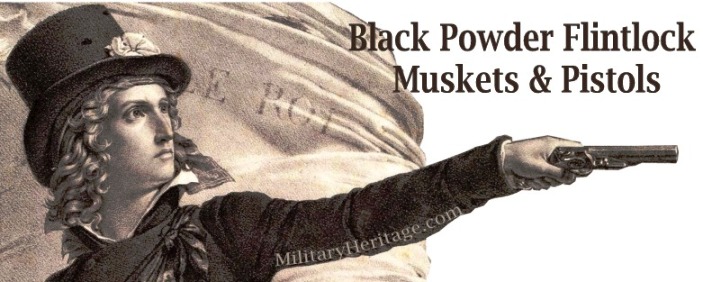
MORE FREE ARTICLES
like this one can be found here:

|

